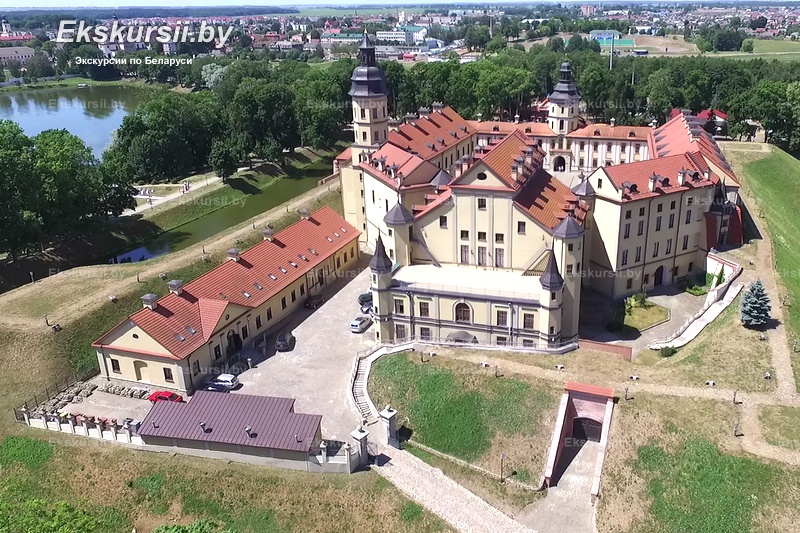- Home
- →
- Attractions
- →
- Nesvizh palace Radziwill
Nesvizh palace Radziwill
Nesvizh Castle is one of the most famous architectural landmarks in Belarus, included in the UNESCO World Heritage List. This magnificent palace and castle complex, located in the town of Nesvizh, attracts tourists with its rich history and stunning architecture. A tour to Nesvizh is an exciting journey into the past, where every stone tells its own story.
The History of Nesvizh Castle
The history of the castle begins in the 16th century, when Nesvizh became the possession of the Radziwill family—one of the most influential families of the Grand Duchy of Lithuania. The castle served not only as their residence but also as a powerful defensive fortress. Over the centuries, it has been rebuilt many times, transforming from a medieval stronghold into a luxurious palace in the Baroque style. Today, tours in Belarus often include a visit to Nesvizh Castle so tourists can learn about its legends and rich heritage.
Architecture and Interiors of the Castle
Nesvizh Castle amazes visitors with its grandeur and variety of architectural styles. Its exterior blends Renaissance, Baroque, and Classicism elements. Special attention should be given to the palace's interiors: exquisite halls decorated with frescoes and stucco, and vast underground passages that hide many secrets. A tour from Minsk to Nesvizh allows you to see these masterpieces with your own eyes.
The Gardens and Parks of Nesvizh Castle
Equally impressive are the surrounding gardens and parks, created in the style of famous European landscape parks. Visitors can stroll along picturesque alleys, admire the views of the castle pond, and enjoy the tranquil atmosphere. The combination of natural beauty and architectural splendor makes a walk through the parks of Nesvizh an unforgettable part of the tour.
How to Book a Tour to Nesvizh Castle
If you want to visit this amazing monument, you can easily book a tour to Nesvizh Castle. The journey to Nesvizh will be a real discovery for history and architecture enthusiasts. You can book a tour as part of excursion packages: Mir - Nesvizh Tour; Nesvizh Castle Tour
Group excursions - Nesvizh palace Radziwill
| Date | Tour | More places | Price adult | Price child up to 18 years | ||
|---|---|---|---|---|---|---|
| 09:00 19-September (Friday) | Mir Castle - Nesvizh Palace |
|
4'658 ₽ | 4'384 ₽ | Book | |
| 09:00 19-September (Friday) | Mir Castle - Nesvizh Palace |
|
Available seats: +27 | 4'658 ₽ | 4'384 ₽ | Book |
| 09:00 20-September (Saturday) | Mir Castle - Nesvizh Palace |
|
Available seats: +10 | 4'658 ₽ | 4'384 ₽ | Book |
| 09:00 22-September (Monday) | Mir Castle - Nesvizh Palace |
|
Available seats: +28 | 4'658 ₽ | 4'384 ₽ | Book |
| 09:00 23-September (Tuesday) | Mir Castle - Nesvizh Palace |
|
Available seats: +27 | 4'658 ₽ | 4'384 ₽ | Book |
Individual and corporate excursions - Nesvizh palace Radziwill
-
Mir Castle - Nesvizh Palace
- Dates on request
- Duration: 11 hours
- transport services
- excursions according to the program
- certified guide services
-
Minsk - Dudutki - Mir - Nesvizh - Brest - Belovezhskaya puscha (3 days)
- Dates on request
- Duration: 3 day
- excursions according to the program
- meeting/seeing off at the train station
- certified guide services
- transport services
-
Nesvizh - the capital of uncrowned kings
- Dates on request
- Duration: 8 hours
- certified guide services
- transport services
-
Minsk - Dudutki - Mir - Nesvizh (2 days)
- Dates on request
- Duration: 2 day
- excursions according to the program
- meeting/seeing off at the train station
- certified guide services
- transport services
-
Brest - Belovezhskaya puscha - Mir - Nesvizh (2 days)
- Dates on request
- Duration: 2 day
- excursions according to the program
- meeting/seeing off at the train station
- certified guide services
- transport services
-
Brest - Belovezhskaya puscha - Mir - Nesvizh - Minsk (3 days)
- Dates on request
- Duration: 3 day
- excursions according to the program
- meeting/seeing off at the train station
- certified guide services
- transport services







